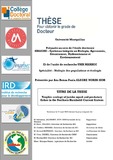Por favor, use este identificador para citar o enlazar este ítem:
https://hdl.handle.net/20.500.12958/2344| Título : | Trophic ecology of jumbo squid and predatory fishes in the Northern Humboldt Current System |
| Autor : | Alegre Norza Sior, Ana Renza Paola |
| Palabras clave : | Ecología Trófica;Calamar Gigante;Dosidicus Gigas;Corriente De Humboldt |
| Fecha de publicación : | 2015 |
| Editorial : | Université Montpellier. Spécialité |
| Resumen : | This work provides a contribution to a better understanding of the trophic ecology of important predators in the Northern Humboldt Current System, the jack mackerel (Trachurus murphyi), the chub mackerel (Scomber japonicus) and the jumbo squid (Dosidicus gigas) by the characterization of the highly variable feeding patterns of these species at different spatiotemporal scales. We provided new knowledge on the comparative trophic behaviour of these species, defined as opportunistic in previous investigations. For that purpose we applied a variety of statistical methods to an extensive dataset of 27,188 non-empty stomachs. We defined the spatial organization of the forage fauna of these predators and documented changes in prey composition according to predators’ size and spatiotemporal features of environment. Our results highligh the key role played by the dissolved oxygen. We also deciphered an important paradox on the jumbo squid diet: why do they hardly forage on the huge anchovy (Engraulis ringens) biomass distributed of coastal Peru? We showed that the shallow oxygen minimum zone present off coastal Peru could hamper the co-occurrence of jumbo squids and anchovies. In addition, we proposed a conceptual model on jumbo squid trophic ecology including the ontogenetic cycle, oxygen and prey availability. Moreover we showed that the trophic behaviour of jack mackerel and chub mackerel is adapted to forage on more accessible species such as for example the squat lobster Pleurocondes monodon and Zoea larvae. Besides, both predators present a trophic overlap. But jack mackerel was not as oracious as chub mackerel, contradictorily to what was observed by others authors. Fish diet presented a high spatiotemporal variability, and the shelf break appeared as a strong biogeographical frontier. Diet composition of our fish predators was not necessarily a consistent indicator of changes in prey biomass. El Niño events had a weak effect on the stomach fullness and diet composition of chub mackerel and jack mackerel. Moreover, decadal changes in diet diversity challenged the classic paradigm of positive correlation between species richness and temperature. Finally, the global patterns that we described in this work, illustrated the opportunistic foraging behaviour, life strategies and the high degree of plasticity of these species. Such behaviour allows adaptation to changes in the environment. |
| Descripción : | Tesis (PhD.). -- Université Montpellier. Spécialité : Biologie des populations et écologie |
| URI : | https://hdl.handle.net/20.500.12958/2344 |
| Aparece en las colecciones: | Tesis de Postgrado |
Ficheros en este ítem:
| Fichero | Descripción | Tamaño | Formato | |
|---|---|---|---|---|
| ALEGRE Ana -PhD.pdf | 9,26 MB | Adobe PDF |  Visualizar/Abrir |
Este ítem está sujeto a una licencia Creative Commons Licencia Creative Commons

